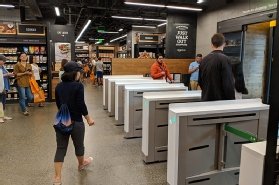
madgooch - stock.adobe.com
Top computer vision retail uses and how they enhance shopping
Computer vision technology can help retailers make shopping in stores faster and easier for customers, while also improving checkout accuracy and theft prevention.
The advent of the web and online shopping caused a major disruption in the retail industry. However, it was never realistic to claim that brick-and-mortar retail is dead. For example, market research firm Statista reported that e-commerce accounted for only 9.9% of total U.S. retail sales in the fourth quarter of 2018. It's why Amazon is adding several different types of retail stores.
At the same time, Walmart, Target, Best Buy and other brick-and-mortar retailers have made strong inroads into e-commerce. That was necessary, but it's not sufficient. Another big goal should be to make the shopping experience in retail stores faster, more accurate and more enjoyable. AI has a central role to play in that effort, and computer vision is one aspect of AI that increasingly is finding its way into retail environments.
One thing to note upfront is that computer vision retail tools are almost never used in an AI void. While machine learning and deep learning models can be run against videos and images for both analytical and operational uses, other techniques must be integrated into a retail computer vision system to track what is happening in a store and act on the information it generates.
To get a better understanding of that, let's look at how the use of computer vision in retail stores can help achieve the three shopping improvements mentioned above.
Using computer vision to speed up shopping
One of the wish list items for consumers who lead busy lives is the ability to get basic tasks done more quickly so they have more time for enjoyable activities. To many people, that's one of the big advantages of e-commerce. One way for brick-and-mortar retailers to retain customers is to use computer vision and associated AI tools to enhance the in-store experience.
One method of speeding up the shopping process uses computer vision indirectly. Positioning items in a store has always been a challenge for retailers, which have long used analytics tools to try to improve product placement on shelves. The problem is that such methods -- market basket analysis, for example -- are only able to analyze patterns about purchases.
On the other hand, analytics combined with computer vision can help retailers to better optimize store layouts. When people walk into a store, a vision system can track their movements through the store and build a heat map that shows where the customers are focusing their attention, with links to information about the products that are on those shelves. Such heat maps can be used to more accurately analyze store traffic and identify layout changes to streamline shopping.

Also, instead of just tracking what people buy at the register, computer vision technology can be used to report on what customers looked at but didn't purchase, providing additional insights into shopping patterns that might be useful to store managers.
Another area where computer vision retail deployments will help speed up shopping is at checkout. Right now, both cashiers and customers using self-checkout devices are often slowed down by problems in getting barcodes to accurately register products.
As the visual recognition features in computer vision technology improve further, it will be incorporated into checkout systems to more quickly identify and ring up items. In its Amazon Go convenience stores, Amazon is going even farther: It uses a combination of computer vision and machine learning to automatically charge customers for items they take from the shelves, eliminating the checkout process altogether.
More accuracy and better security
Computer vision retail technology can not only speed checkout but also improve its accuracy -- and being able to more accurately identify the products that shoppers are purchasing helps both the store and the retail customer experience.
That's particularly the case in grocery stores. For instance, when a piece of produce doesn't have a checkout code sticker, cashiers or people doing self-checkout might pick the wrong item from a list on the display. Computer vision tools can correctly identify the items and trigger alerts for self-checkout assistance in case of problems.
In addition, computer vision helps retailers address another critical business issue: theft and fraud prevention. Automated visual inspection, both in store aisles and at checkout, can catch shoplifters more readily than existing security methodologies. Now, a security person or team typically watches multiple video feeds from security cameras at once; in a busy store, suspicious activity might be missed.
Computer vision driven by machine learning or deep learning algorithms enables a system that doesn't get tired or distracted to focus on images, identify potential risks and rapidly notify store personnel, who can then take action. The vision technology doesn't replace human security -- rather, it takes over the mundane portions of security tasks and helps improve the accuracy of security monitoring in stores.
Location data and computer vision add new options
While all of the above adds to the enjoyability factor for shoppers (shoplifters excluded), computer vision can provide even more immediate benefits in that regard. The ability to use location technology for ad placements or promotional offers on mobile phones continues to improve; nowadays, an ad can be placed or an offer made as you near or enter a store. Going forward, it's likely that location data will increasingly be linked with computer vision inside stores.
For instance, GPS location on phones and visual information in the store can be combined to identify and reach out to customers while they shop. A retail chain gets a better view of who is where in a store, potentially enabling it to send instant ads and coupons to people's phones or to suggest other product options that are related to items they're near.
While some older people might find that a bit creepy, many younger shoppers, used to the pervasiveness of mobile phones, are likely to see it as a way to save money, speed up shopping and lead to new product discoveries.
No single technology is a silver bullet, of course. But using computer vision in retail stores can help improve the shopping experience and give customers more reasons to keep coming back. And that's a good look for retailers.








